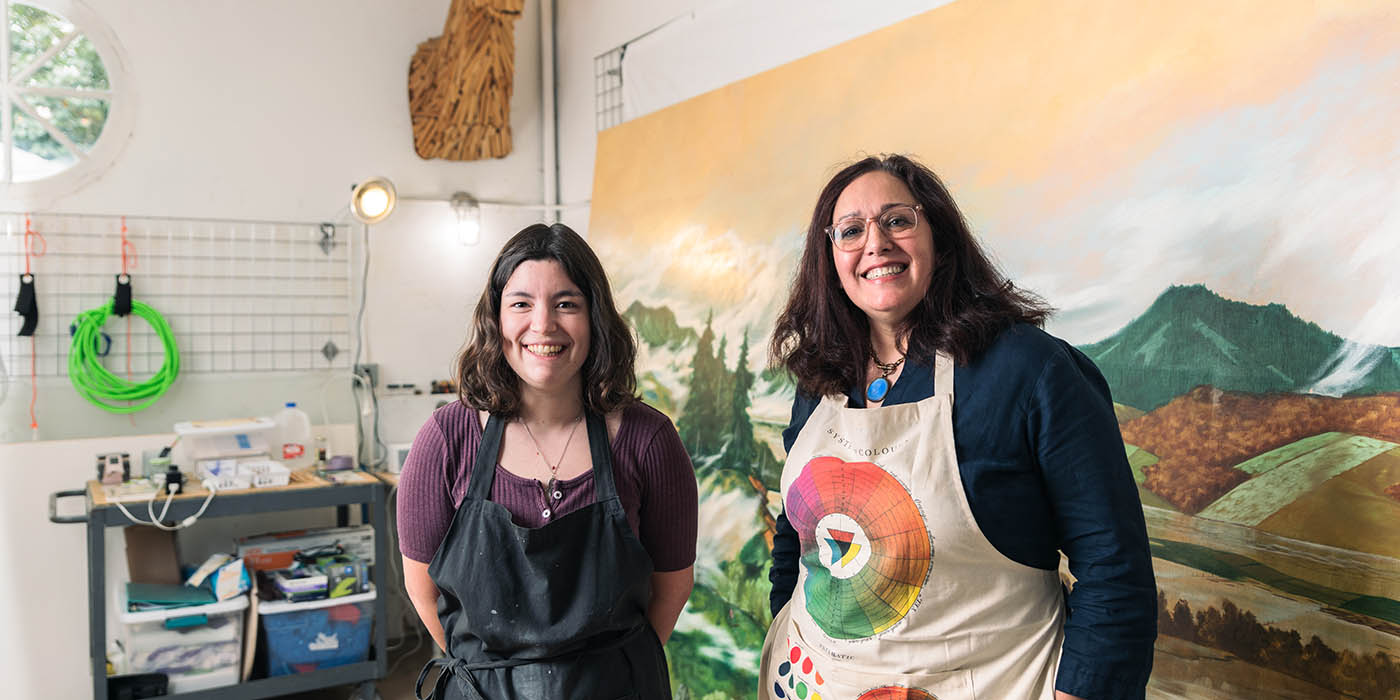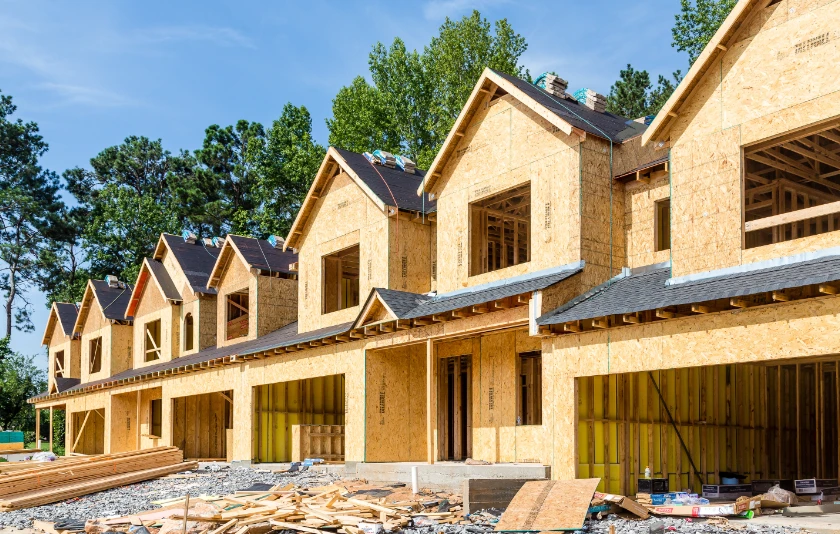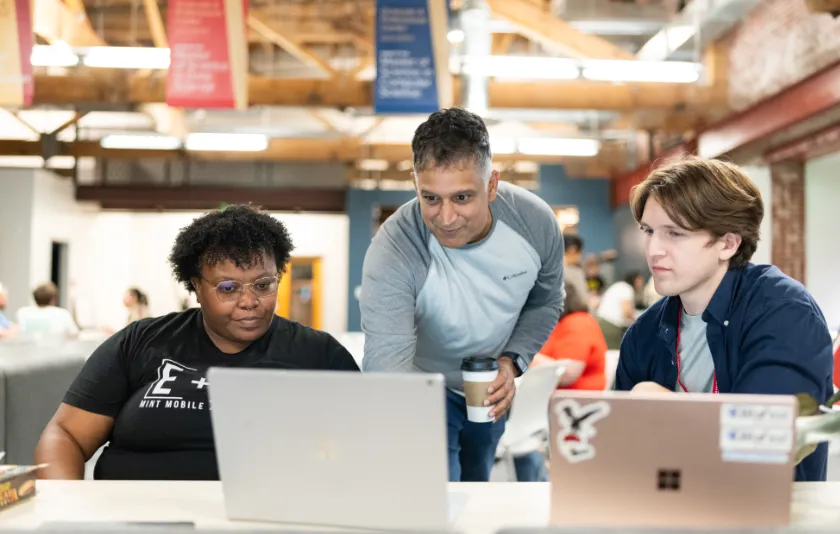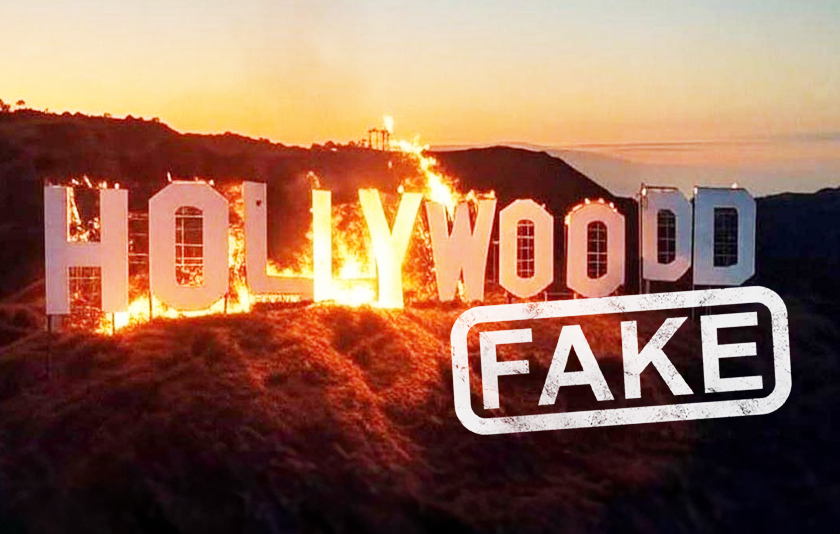A landscape mural created by one of Oregon’s most famous artists has emerged from the walls of a Salem home and will soon be on display at Hallie Ford Museum of Art (HFMA).
Carl Hall, a former Willamette University professor who gained national recognition in the ‘50s for blending realism, surrealism and romanticism in his work, painted a roughly 7-foot high, 29-foot long mural capturing the Willamette Valley and hills of West Salem in the dining room of a local doctor.

View a 12-foot panel from the mural Sept. 18 until Dec. 18 at HFMA’s exhibit, “Time in Place: Northwest Art from the Permanent Collection.”
Likely the largest painting Hall ever created, the mural’s public appearance represents a long journey from the Fairmount Hill home to the museum, a dedicated effort by HFMA to preserve work by one of the region’s great artists and an exceptional student learning opportunity.
Joanna Gold ’22, an art history major, spent the summer restoring the mural with a Portland conservator. She heard about the project through her internship at HFMA, which is available to students of any major.
“If you’re interested in working at a museum, this is the best experience you can probably get,” she said.
Early recognition
Even if you don’t know Hall’s paintings, you may have heard of him.
A gallery at HFMA that bears his name — a nod to his career at Willamette from 1948 until 1986 — always features at least one piece of his work, but his paintings also appear in the permanent collections of galleries up and down the Willamette Valley, throughout the Pacific Northwest and as far east as New York’s Whitney Museum of American Art and the Museum of Fine Arts in Boston.
Hall exhibited talent from an early age. Born in 1921 and raised in Detroit, Michigan, his early drawing skills led him to win a scholarship at an art school in the city and be mentored by Cuban painter Carlos Lopez, a well-known painter at the time. Under Lopez’s guidance, Hall submitted his work successfully to national exhibitions, but his future in art was interrupted in 1942 by military duty. Basic training introduced him to Oregon, and he loved the state so much he vowed to return.
During Hall’s tour of duty in the Philippines and Okinawa, Julien Levy, a famous Manhattan gallery owner and art dealer, wanted to feature his work. Levy’s interest was no small thing — he was known for supporting surrealists like Salvador Dali, Jean Cocteau and Max Ernst — and Hall’s association with the gallery boosted his national profile, as did a 1948 Life magazine feature that referred to him as a “magic realist.”
By then, Hall had a growing family and was teaching at Willamette — a professor discovered his art then offered him a job — and he was back living in a state he once referred to as “Eden again.”
Excitement over his work began to build at home and abroad, though local reaction was initially mixed. Roger Hull, professor emeritus of art history and colleague of Hall’s at Willamette, said Hall took Salem by surprise.
“People saw in him a remarkable talent and welcomed him to the community, but he was something of an idiosyncratic figure in Pacific Northwest art — he had a very meticulous way of describing forms and delineating edges, which resulted in highly-focused, closely-detailed imagery,” he said. “That’s why he was described as a magic realist. Northwest painting at the time tended to be more fluid, more painterly, so Carl’s style was a cause for fascination. Oregon artists didn’t know exactly what to make of it, so he was a little bit of an outsider.”
Extravagant view
In a departure from Hall’s detailed, structured style on easels, the mural presents a more generalized approach that may have better accommodated the surroundings, said Hull.
Seven panels of mountain and valley views encompass the dining room, interrupted only by doorways, a bow window and built-in cabinets — even light switch plates disappear into the landscape. The largest of the panels, which will be featured at the HFMA exhibit, depicts the Willamette Valley as seen from that room. According to family members, Hall produced the mural in 1948 in exchange for the doctor’s medical services.
For more than 50 years it remained in the Georgian-style home until a renovation by the homeowners spurred its donation to the university in 2006. Assistance from Portland conservator Nina Olsson was required to remove the panels from the plaster walls — Hall painted the murals on a pre-existing canvas wall finish, and the arduous removal process involved mechanically separating the wall finish from the plaster with small spatulas — but the museum’s hopes to feature the art in an exhibit never transpired. The mural sat in Olsson’s storage until now.
Jonathan Bucci, curator of collections and exhibitions at HFMA, felt the timing was right to display it.
“One thing I wanted to do is look for some of the spectacular pieces that we haven’t exhibited before, specifically those depicting the region and Oregon,” he said. “That was certainly one of the goals with this exhibition and it was a great opportunity to bring this mural conservation project to a conclusion.”
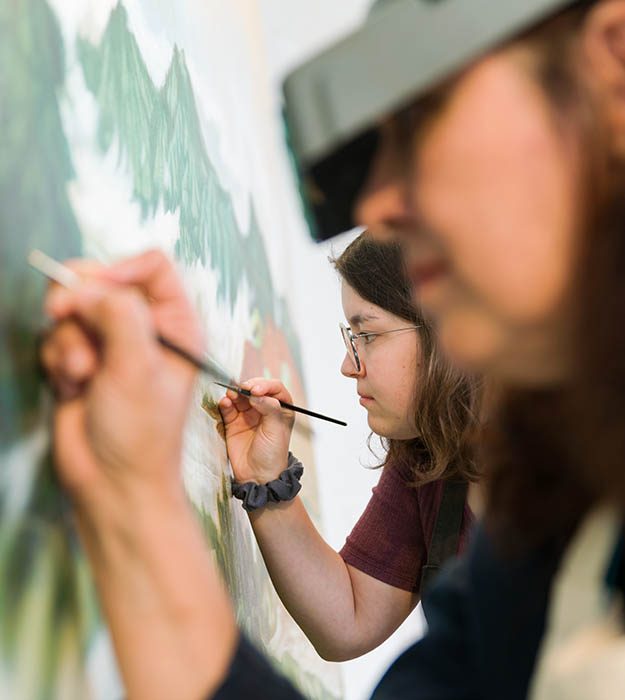
Since early July, Olsson has been working with Gold to carefully remove debris from the reverse of the mural, structurally repair the canvas, mount the mural on a new support and restore the image by inpainting ahead of its public debut.
After the exhibit ends, the mural is planned for permanent display outside of the John C. Paulus Lecture Hall at Willamette's College of Law.
Gold was a museum work study student when Bucci first introduced her to Olsson, who was open to offering her a conservation internship. As a child who dreamed of visiting the Vatican to sift through old literature, Gold said discovering the project was serendipitous — she’s considering paper conservation as a career, and the internship is relevant experience for future graduate programs.
“Conservation is a very niche field, and it’s hard to find those opportunities, especially if you live somewhere where there aren’t a lot of conservators,” she said. “I got really lucky.”
Olsson, who has relocated a dozen murals in her 30-year career, said “bench work” like this is incredibly important for future conservators to understand the physical and intellectual demands the field requires. But beyond the utility of the project, she is excited to introduce an extraordinary work of art to the public.
“Hall really captured the essence and beauty of the Willamette Valley, and he was so connected to Salem and the environment,” she said. “I think this will be a timeless piece that will never lose its appeal to people who love that area.”
